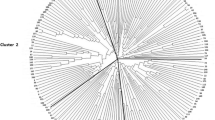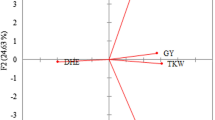Summary
Allozyme variation in the tetraploid wild progenitor of wheat, Triticum dicoccoides, was studied for the proteins encoded by about 50 gene loci in 457 individuals representing 12 populations from Israel. Six spikelet morphological traits were measured in the same populations. The results indicate that: (a) 16 loci (= 32%) were monomorphic in all 12 populations, 15 loci (= 30%) were locally polymorphic, and 19 loci (= 38%) were regionally polymorphic. All polymorphic loci (but one) displayed high levels of polymorphism (≧ 10%). In Israel, the proportion of polymorphic loci per population, P, in wild wheat averaged 0.25 (range, 0.16–0.38), and the genetic diversity index, He averaged 0.07, (range, 0.03 – 0.12). (b) Altogether there were 110 alleles at the 50 putative loci tested (c) Genetic differentiation of populations included regional and local patterns: (i) The coefficients of genetic distance between populations were high (mean D = 0.10 range, 0.02 – 0.25), and indicated sharp genetic differentiation over short distances, (ii) Common (≧ 10%) but sporadic and localized alleles were frequent (76%), and (iii) Rare alleles were few (only 5 alleles). (d) The patterns of allozyme and spikelet variation in the wild gene pool were significantly correlated with, and partly predictable by, water factors, including those of precipitation, evaporation, and relative humidity as well as of soil type, (e) All six spikelet characters showed statistically significant variation among localities and (f) Allozymic variation was correlated with spikelet variation.
These results suggest in T. dicoccoides: (i) the operation of natural selection in population genetic structure, (ii) local adaptive genetic differentiation caused by diversifying selection through climate and soil, and (iii) the guidelines for sampling these resources for use in wheat breeding programs.
Similar content being viewed by others
Literature
Avivi, L. (1979a): High grain protein content in wild tetraploid wheat Triticum dicoccoides. Proc. 5th Int. Wheat Genet. Symp., Vol. 1 (ed. Rhamanogam, S.), pp. 372–380. New Delhi
Avivi, L. (1979b): Utilization of T. dicoccoides for the improvement of grain protein quantity and quality of cultivated wheats. Monogr. Genet. Agr. 4, 27–38
Brown, A.H.D. (1978): Isozymes, plant population genetic structure and genetic conservation. Theor. Appl. Genet. 52, 145–157
Brown, A.H.D.; Nevo, E.; Zohary, D.; Dagan, O. (1978a): Genetic variation in natural populations of wild barley (Hordeum spontaneum). Genetica 49, 97–108
Brown, A.H.D.; Zohary, D.; Nevo, E. (1978b): Outcrossing rates and heterozygosity in natural populations of Hordeum spontaneum Koch in Israel. Heredity 41, 49–62
Draper, N.R.; Smith, H. (1966): Applied Regression Analysis New York: Wiley
Feldman, M. (1977): Historical aspects and significance of the discovery of wild wheats. Stadler Symp. 9, 121–146
Feldman, M. (1979): Genetic resources of wild wheats and their use in breeding. Monog. Genet. Agrar. 4, 9–26
Feldman, M.; Sears, E.R. (1981): The wild gene resources of wheat. Sci. Amer. 244, 102–112
Frankel, O.H.; Bennet, E. (1970): Genetic Resources in Plants — their Exploration and Conservation. Oxford, Edinburgh: Blackwell
Gerechter-Amitai, Z.K.; Stubbs, R.W. (1970): A valuable source of yellow rust resistance in Israeli populations of wild emmer, Triticum dicoccoides. Euphytica 19, 12–21
Grama, A.; Gerechter-Amitai, Z.K. (1974): Inheritance of resistance to stripe rust (Puccinia striiformis) in crosses between wild emmer (Triticum dicoccoides) and cultivated tetraploid and hexaploid wheat. 2. Triticum aestivum. Euphytica 23, 393–398
Harlan, J.R. (1976): Genetic resources in wild relatives of crops. Crop science 16, 329–333
Harlan, J.R.; Zohary, D. (1976): Distribution of wild wheat and barley. Science 153, 1074–1080
Hart, G.E. (1975): Glutamate oxaloacetate transaminase isozymes of Triticum: evidence for multiple systems of triplicate structural genes in hexaploid wheat. In: Isozymes III Developmental Biology (ed. Markert, C.), pp. 637–657. New York: Acad. Press
Hart, G.E. (1979): Genetical and chromosomal relationships among the wheats and their relatives Stadler Symp. 11, 9–30
Jaaska, V. (1976): Aspartate aminotransferase isoenzymes in the polyploid wheats and their diploid relatives. On the origin of tetraploid wheats. Biochem. Physiol. Pfl. 170, 159–171
Kahler, A.L.; Allard, R.W.; Krazakowa, C.F.; Wehrhahn, C.F.; Nevo, E. (1980): Association between isozyme phenotypes and environment in the slender wild oat (Avena barbata) in Israel. Theor. Appl. Genet. 56, 37–47
Lewontin, R.C. (1974): The Genetic Basis of Evolutionary Change. New York: Columbia University Press
Marshall, D.K.; Brown, A.H.D. (1975): Optimum sampling strategies in genetic conservation. In: Crop Genetic Resources for Today and Tomorrow (eds. Frankel, O.H.; Hawles, J.G.), pp. 53–70. Cambridge: Cambridge University Press
Nei, M. (1972): Genetic distance between populations. Amer. Nat. 106, 283–292
Nei, M. (1975): Molecular Population Genetics and Evolution. Amsterdam: North Holland Publ.
Nevo, E. (1978): Genetic variation in natural populations; patterns and theory. Theor. Pop. Biol. 13, 121–177
Nevo, E.; Zohary, D.; Brown, A.H.D.; Haber, M. (1979): Genetic diversity and environmental associations of wild barley, Hordeum spontaneum, in Israel. Evolution 33, 815–833
Nie, N.H.; Hull, C.H.; Jenkins, J.C.; Steinbrenner, K.; Bent, D.H. (1975): Statistical Package for the Social Sciences. New York: McGraw Hill Book
Rao, P.S.; Smith, E.L. (1968): Studies with Israeli and Turkish accessions of Triticum turgidum L. emens. var. ‘dicoccoides’ (Koern) Bowden. Wheat Information Service 26, 6–7
Rick, C.M.; Fobes, J.F.; Holle, M. (1977): Genetic variation in Lycopersicon pimpinellifolium: evidence of evolutionary change in mating systems. Plant Syst. Evol. 127, 139–170
Torres, A.M.; Diedenhofen, U.; Johustone, I.N. (1977): The early allele of alcohol dehydrogenase in sunflower populations. J. Hered. 68, 11–16
Wright, S. (1965): The interpretation of population structure by F-statistics with special regard to systems of matings. Evolution 19, 395–420
Zohary, D. (1969): The progenitors of wheat and barley in relation to domestication and agricultural dispersal in the old world. In: The Domestication and Exploitation of Plants and Animals (eds. Ucko, P.J.; Dimbley, G.W.), pp. 47–66. London: Duckworth
Zohary, D. (1970): Wild wheats. In: Genetic Resources in Plants their Exploration and Conservation (eds. Frankel, O.H.; Bennet, E.), pp. 239–247. Oxford, Edinburgh: Blackwell
Author information
Authors and Affiliations
Additional information
Communicated by R. C. Lewontin
Rights and permissions
About this article
Cite this article
Nevo, E., Golenberg, E., Beiles, A. et al. Genetic diversity and environmental associations of wild wheat, Triticum dicoccoides, in Israel. Theoret. Appl. Genetics 62, 241–254 (1982). https://doi.org/10.1007/BF00276247
Received:
Issue Date:
DOI: https://doi.org/10.1007/BF00276247




